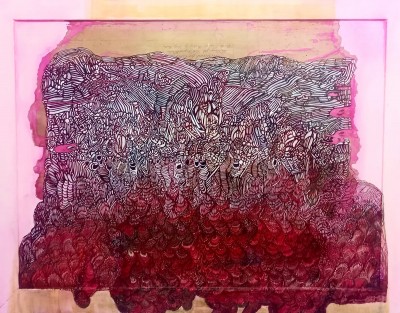This week in the STAC Chapel in Clonmel, I had a public “artists’ conversation” with Austin McQuinn a visual artist and performance maker. Austin’s solo show at the South Tipperary Arts Centre STAC is entitled Some signs are secret, some manifest and features a large sculptural work that resembles a Norman tower but covered in hundreds of Aran sweaters sewn together into a single enveloping piece, as well as paintings/collages made on, and in relation to, found often discarded prints.

Some of the prints are of religious scenes (Austin retains the titles of the original prints even if the images are completely transformed by his intervention) but most are images from the Victorian war painter Elizabeth Thompson, who became Lady Butler in Bansha, Co. Tipperary. Austin’s work often engages with found materials.
As well as the painting and sculpture, Austin makes live performance and when I met him today he had completed a 24 hour performance, Imperial Lunatic, in the STAC Chapel, which was formerly the garrison chapel of the Kickham Barracks. Chalk from his performance was still visible on the floor in front of us. It was in that chapel, before the barracks was redeveloped as a civic space for Clonmel that I met Austin after a long hiatus, when he came to see me perform Unreeling in the Tipperary Dance Platform, in 2021. Seeing him in the audience before the performance that day, I recognised how Unreeling and all my dancing is a celebration of having survived our shared history, some of which relates to being gay boys in an Irish boarding school in the 80s. I appreciated his presence at the performance as an act of support and solidarity and so I was delighted to be invited back to the same chapel that had since held his solo performance to talk about our histories, our futures, our inspirations and our routes to working expressively through our bodies.
The conversation covered a lot of territory but I was often drawn to the fact that we were pointing to places in the space where significant events happened: I pointed to where he was sitting when I performed, he gestured to where elements of his recent performance happened, we could locate where we spoke after the show. The space was charged with these memories that are presences now as real as the chalk that still marked the floor, presences that claim space alongside the official military and religious narratives in the chapel’s history. We, as many others have and will, are making different stories and experiences material in the chapel and in ourselves, working with histories that have been lived through us but that exceed us as individuals.
I’m grateful for the opportunity this encounter and re-encounter has provided me to think about the path we’ve traveled so far, so that I can see a little more clearly why it matters so much to me to keep dancing myself and to keep making dancing possible for others.


Post a Comment